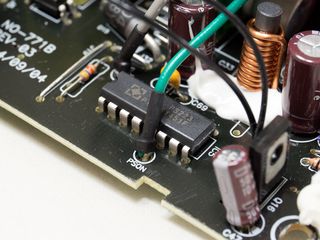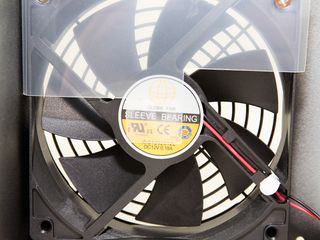SilverStone Strider Gold S V2 750W Review
SilverStone is the only company with so many compact PSUs in its portfolio. A while ago, it released the second version of the Strider Gold S with 750W of capacity.
Why you can trust Tom's Hardware
A Look Inside And Component Analysis
Parts Description
Before proceeding with this page, we strongly encourage you to a look at this article, which will provide you with valuable information about PSUs and their inner workings, allowing you to understand the information we're about to cover. Our main tools for disassembling PSUs are a Thermaltronics soldering and rework station and a Hakko 808 desoldering gun.
| Primary Side | |
|---|---|
| Transient Filter | 4x Y caps, 2x X caps, 2x CM chokes, 1x MOV, 1x CMD02X |
| Inrush Protection | NTC Thermistor & Relay |
| Bridge Rectifier(s) | 1x |
| APFC MOSFETs | 2x Infineon IPA50R140CP (550V, 15A @ 100 °C, 0.14-ohm ) |
| APFC Boost Diode | 1x CREE C3D08060A (600V, 8A @ 152 °C) |
| Hold-up Cap(s) | 1x Rybycon (400V, 560uF, 3000h @ 105 °C, MXG) |
| Main Switchers | 2x Infineon IPA50R140CP (550V, 15A @ 100 °C, 0.14-ohm ) |
| APFC Controller | Infineon ICE3PCS01 |
| Switching Controller | Infineon ICE2HS01G |
| Topology | Primary side: Half-Bridge & LLC Resonant Converter Secondary side: Synchronous Rectification & DC-DC converters |
| Secondary Side | |
| +12V MOSFETs | 4x International Rectifier IRFB7437 (40V, 180A @ 100 °C, 1.5-mohm) |
| 5V & 3.3V | DC-DC Converters: 8x Infineon IPD060N03L G (30V, 50A @ 100 °C, 6 mohm) PWM Controller: APW7159 |
| Filtering Capacitors | Electrolytics: Nippon Chemi-Con (105 °C, KY, KZE) Polymers: Nippon Chemi-Con, Teapo |
| Supervisor IC | SITI PS223 (OVP, UVP, OCP, SCP, OTP ) |
| Fan Model | Globe Fan S1202512L (120mm, 12V, 0.18A, 67.28CFM, 2000 RPM, 34 dB[A], Sleeve Bearing) |
| 5VSB Circuit | |
| Standby PWM Controller | STR-A6069H |





In this case, SilverStone broke ties with its favorite OEM, Enhance Electronics, and went to Sirfa for its second-gen ST75F-GS. While the first version used an Active Clamp Reset Forward (ACRF) topology, this one utilizes a half-bridge topology along with an LLC resonant converter for increased efficiency. This means that, on paper, the ST75F-GS V2's platform (Sirfa HPM) is inferior to the one used in the first version of this product. Our test equipment will be the final judge of that, though.
In the secondary side, Sirfa used a synchronous design for rectifying the +12V rail along with two DC-DC converters for generating the minor rails. In addition, all electrolytic capacitors are provided by Chemi-Con, while all polymer caps on the main PCB are by Teapo. On the modular board, we only ran across Chemi-Con polymer caps. Besides the sleeve bearing fan, another compromise in the build quality of this PSU is its single-layer PCB. Obviously Sirfa wanted to cut production costs. But it shouldn't have gone cheap on the fan selection, at least.



The first part of the transient filtering stage is on the AC receptacle and includes two Y and a single X cap. On the latter, we found a CMD02X IC that blocks current through the cap's bleeding resistor when AC voltage is connected to increase efficiency. The second part of the transient or EMI filter is on the main PCB and includes one X and two Y caps, two CM chokes and an MOV that's installed after the bridge rectifier. All in all, the EMI filter is complete.


The single bridge rectifier is bolted on a dedicated heat sink. Unfortunately, we couldn't identify it since its markings are on the hidden side.






In the APFC converter, two Infineon IPA50R140CP FETs are used along with a single CREE C3D08060A boost diode. The bulk capacitor is provided by Rubycon (400V, 560uF, 3000h @ 105 °C, MXG) and it has enough capacity to offer a pretty long hold-up time. We would, however, prefer a higher-voltage cap here, since 400V is close to APFC's DC bus voltage (380V). The APFC controller is installed onto the solder side of the main PCB and it is an Infineon ICE3PCS01 IC.




The main switchers are a couple of Infineon IPA50R140CP FETs arranged into a half-bridge topology. The LLC resonant controller is installed on a vertical daughterboard, and it is provided by Infineon (ICE2HS01G).





In the secondary side, a large heat sink holds six International Rectifier IRFB7437 FETs that are responsible for regulating the +12V rail. The same rail feeds two DC-DC converters, which generate the minor rails. The common PWM controller of the DC-DC converters is an ANPEC APW7159 IC, and on each VRM, four Infineon IPD060N03L G FETs are used.






Polymer caps from Teapo provide filtering on the main PCB and the DC-DC converters, along with several electrolytic Chemi-Con caps. We find some more polymer caps by Chemi-Con at the front side of the modular board, too. Sirfa's cap choices appear solid, although it didn't use only Japanese caps. Still, the Teapo polymer ones are of good enough quality. Moreover, in the front side of the modular board where airflow is restricted, Sirfa only used high-quality Chemi-Con polymer caps.


The standby PWM controller is an STR-A6069H IC that can provide up to 19.5W with universal voltage input (85V-265V) and an open frame design. It easily covers the 15W ceiling that SilverStone states for this PSU's 5VSB rail.

The protection IC, a SITI PS223, is installed onto the main PCB. It supports all of the basics, including Over-Temperature Protection (OTP).







The soldering looks good. It might not be up to Delta's or Flextronic's level, but it's definitely a step forward for Sirfa. We carefully examined the PCB and didn't find any incomplete joints or problematic leads.

The fan is by Globe Fan; its model is S1202512L (120mm, 12V, 0.18A, 67.28 CFM, 2000 RPM, 34 dB[A]). Although the official specs mention 2000 RPM, we only measured 1500 RPM at full speed, classifying it in the low/mid-speed category. Again, the major downside is its plain sleeve bearing, which has a much lower lifetime compared to ball bearings or Fluid Dynamic ones. A sleeve-bearing fan has no place in a PSU that costs $130.
Current page: A Look Inside And Component Analysis
Prev Page Packaging, Contents, Exterior And Cabling Next Page Load Regulation, Hold-Up Time And Inrush CurrentStay on the Cutting Edge
Join the experts who read Tom's Hardware for the inside track on enthusiast PC tech news — and have for over 25 years. We'll send breaking news and in-depth reviews of CPUs, GPUs, AI, maker hardware and more straight to your inbox.
Aris Mpitziopoulos is a Contributing Editor at Tom's Hardware US, covering PSUs.

Save $250 on Asus' ROG Zephyrus G16 (2024) with Intel Core Ultra 9 185H CPU, RTX 4070 graphics, and a 240Hz OLED screen

Commodore 64 claimed to outperform IBM's quantum system — sarcastic researchers say 1 MHz computer is faster, more efficient, and decently accurate

Gigabyte officially unveils premium ice-themed motherboard and GPU — XTREME Prestige Limited Edition lineup arrives
-
Eggz At first glance, I thought this was a 750 w in an SFS form factor. Womp! . . . Still seems like a decent PSU, though.Reply